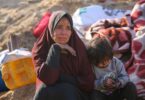Ido Levy
“In the Valley of Syria…Heaven and Hell!” This was the title of a featured editorial in the August 12 edition of the Islamic State (IS) newsletter al-Naba, devoted to touting the group’s recent exploits in the Badia desert region of central and east Syria. The article highlighted casualties inflicted on forces loyal to embattled dictator Bashar al-Assad, including Syrian military units, pro-Assad paramilitaries, and militias aligned with Iran and Russia. Indeed, IS has maintained the volume and lethality of such attacks despite facing hundreds of Russian airstrikes and the presence of some 25,000 militiamen deployed in support of Assad’s forces.
Notably absent from the editorial was any mention of the Syrian Democratic Forces (SDF), the predominantly Kurdish militia supported by the U.S.-led coalition. The SDF controls most of the territory east of the Euphrates River, spanning the provinces of Hasaka, Deir al-Zour, and Raqqa. According to the U.S. Defense Department’s Office of the Inspector General, this territory includes detention centers holding around 10,000 IS fighters, as well as al-Hawl refugee camp, where many IS-linked individuals can be found among the 60,000 residents, mostly women and children. Although IS has threatened to establish itself more firmly in the camp and break its fighters out of detention, it has so far failed to make significant gains in these areas due to SDF and coalition counterterrorism operations.
In other words, two IS insurgencies are being waged in Syria: a high-intensity campaign west of the Euphrates, and a second campaign east of the river that is struggling to establish solid footing. The following analysis is based on statistics from the Armed Conflict Location & Event Data Project (ACLED), which collects information from open-source material and local partners. Additional U.S. and Syrian sources were consulted to help capture the dynamics of these insurgencies.
The “Hell” West of the Euphrates
IS attack claims issued via al-Naba have continued steadily this year, totaling 303 incidents in Syria through September 9. ACLED has compiled figures for violent incidents in Syria as well, covering the period January-July 28. Upon further analysis, at least 219 of the incidents in its database can be classified as IS attacks: 117 against pro-regime elements and 38 against the SDF, resulting in 624 total fatalities. Notwithstanding the difficulty of obtaining precise fatality statistics in this conflict, the locations and death counts reported for these incidents suggest that the group’s highest-intensity operations were concentrated west of the Euphrates (for graphics illustrating these trends, see the web version of this PolicyWatch).
A look at specific incidents supports this notion, showing that IS has been consistently able to produce high-casualty attacks against pro-regime forces:
February 2-3: An ambush on the road between Hama and Raqqa kills 19 pro-Assad personnel
February 17-20: An estimated 15 or more pro-Assad personnel are killed in Deir al-Zour, and 15 others are abducted from a troop bus in Hama
June 3-5: Ambushes and landmine explosions across the Badia kill 23 pro-regime personnel, including a Syrian brigadier general and an officer in Iran’s Islamic Revolutionary Guard Corps (according to the Syrian Observatory for Human Rights)
June 25: A convoy attack against Iran-backed forces in Sukhna kills or wounds 25, including two senior Revolutionary Guard officers (according to the U.S. Defense Department)
IS has executed such attacks despite being heavily outnumbered and outgunned by the regime. Pro-Assad forces tend to rely on tanks and Russian air support to counter the group, delivering as many as 200 airstrikes in a single day according to the Syrian Observatory for Human Rights. At best, however, these intense operations have enabled Assad to keep the military situation stagnant, not turn the tide against IS—echoing the regime’s repeated failures to dislodge materially inferior forces in other theaters (e.g., Deraa and Idlib) or gain ground against the SDF. Meanwhile, the spoils from raids on regime positions have helped IS sustain itself.
Relative Stability East of the Euphrates, but Dangers Loom
Since driving IS from its last territorial stronghold in March 2019, the SDF—with crucial coalition assistance—has gradually restored stability to its territories, known as the Autonomous Administration of North and East Syria (AANES) or Rojava. According to ACLED, of the 624 fatalities resulting from IS attacks in Syria through July 28, 72% were among pro-Assad forces and only 7% among the SDF. Pro-regime forces regularly sustain double-digit casualties in clashes with IS, yet the SDF has never sustained more than four.
This disparity is a function of effective SDF-coalition coordination in counterterrorism operations targeting key IS figures. The most prominent example was the late March sweep through al-Hawl, in which some 5,000 SDF personnel arrested 158 individuals suspected of links to IS. Killings in the camp decreased noticeably thereafter, from 45 in the first quarter of 2021 to 15 in the second, assuaging fears that an IS comeback was imminent. Since then, frequent joint patrols and precise operations backed by sound intelligence have enabled the SDF to apprehend numerous IS commanders, explosives experts, and other personnel (e.g., the SDF’s Military Observation Desk reported 64 arrests in July).
The apparent effect on the group’s attacks has been measurable. According to the Qamishli-based Rojava Information Center, IS attacks in the AANES were halved each month beginning in May, falling to 12 in July, a record low since March 2019. This decrease is reflected in IS reporting as well. In fact, a study issued earlier this month by the Middle East Institute noted that IS may have downplayed its ineffectiveness in the AANES at various points by deliberately underreporting its attacks in the Badia.
Still, IS remains active in SDF territories. Although it has been unable to make headway in freeing detainees, it continues to subvert AANES control by intimidating and extorting locals in rural towns, which helps it obtain new funds and recruits while discouraging people from joining the SDF. And despite the relatively low casualty counts compared to Assad’s forces, SDF personnel are occasionally killed or abducted during IS hit-and-run attacks, kidnappings, and bombings. Hence, the SDF-coalition partnership must continue in order to promote stability in SDF territories.
Policy Implications
The SDF’s remarkable performance this year is further evidence of how even a small, sustained U.S. footprint can substantially boost a partner force’s capabilities. In Syria, 900 American troops effectively support over 100,000 SDF personnel. The organization’s fragile progress is heavily dependent on the U.S. contingent, whose provision of high-quality intelligence, airpower, advice, and operational/logistical support has proven indispensable against IS. In the wake of the Afghanistan withdrawal, the Biden administration should put to rest any notions of pulling troops out of Syria; instead, it should continue reassuring the SDF loudly and publicly that America has no plans to leave the AANES.
A strong partnership is particularly important given the situation west of the Euphrates. Pro-Assad forces have not been able to crack IS in the Badia, so coalition advisors should consider the possibility that the group might reestablish a territorial presence there in the near term—especially if regime forces decide to focus their strength elsewhere (e.g., in response to developments in Deraa or Idlib). A resurgent IS on the southern flank of the AANES would pose significant risks, in part because the SDF still views Turkish incursions from the north as its biggest threat and has generally dedicated more resources to that front.
To counter these risks, the coalition should help local partners prepare for the potential return of potent IS tactics such as frequent vehicle-borne suicide attacks. It should also continue helping the SDF improve its defenses at prisons and al-Hawl. Although fatality rates in the camp have remained at the low rate achieved last quarter, the situation could worsen again at any point, so the SDF must be prepared to carry out further sweeps and aggressively pursue IS facilitators who help detainees coordinate with the outside world. At the same time, the Biden administration should press foreign governments to accelerate their repatriation of camp inhabitants, a plurality of whom are Iraqi (31,000), though as many as 60 other countries are represented. Local authorities should also expand their tribal engagement and development of civil institutions—a crucial step in preventing IS from embedding itself in local communities.
Ido Levy is an associate fellow with The Washington Institute who specializes in military and counterterrorism operations, particularly relating to jihadist groups.






